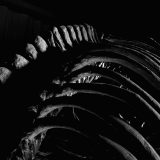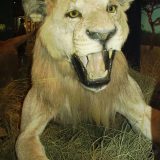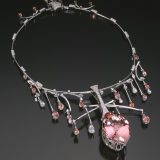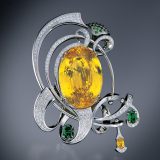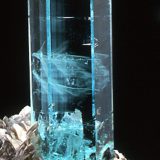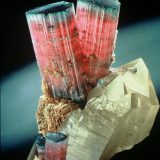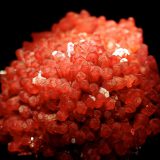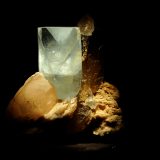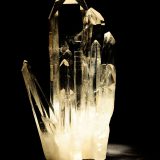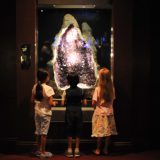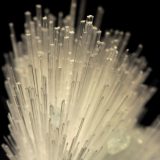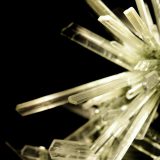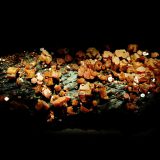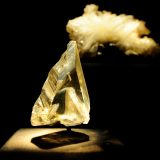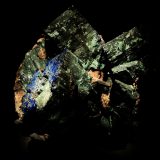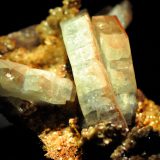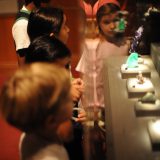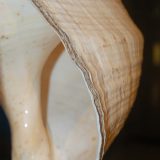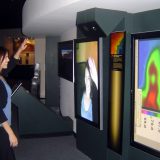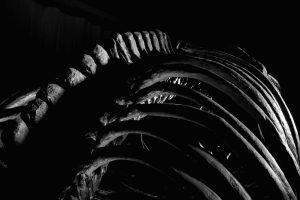
Morian Hall of Paleontology
The Morian Hall of Paleontology is packed with prehistoric beasts, and does not have the same stagnant displays of ancient skeletons standing in a row that many visitors are accustomed to seeing. Rather, the predators and prey in the new paleontology hall are in action—chasing, eating and escaping as they struggle for life. Embark on a “prehistoric safari” that also includes the grand saga of human evolution—from tree-climbing australopithecines to courageous mammoth-hunters.
Cullen Hall of Gems and Minerals
This spectacular hall houses the world’s finest display-quality collection of minerals, which includes more than 750 beautifully crystallized mineral specimens. Discover some of the rarest and most stunning minerals ever uncovered. Walk-around display cases and fiber-optic lighting provide an optimum view of these dazzling treasures.
The Lester and Sue Smith Gem Vault
The Smith Gem Vault contains some of the most coveted and mesmerizing polished and cut gems and jewels ever displayed in a single exhibit. Floating lightly in space and radiating intense color, the jeweled masterpieces on display in the Smith Gem Vault literally take your breath away. As a complement to the Museum’s existing, world-renowned collection of the rarest and most beautiful mineral crystals, the Smith Gem Vault collection includes the world’s finest aquamarine, the largest emerald crystal ever recovered in North America and the world’s finest boulder opal in addition to dazzling examples of diamonds, rubies, sapphires, emeralds, aquamarines, topazes, amethysts, alexandrites, and tourmalines.
Wiess Energy Hall
The most sophisticated and comprehensive energy exhibit in the world, the Wiess Energy Hall explores the application of scientific concepts and advanced technology in the oil and gas industry. Discover the fascinating processes through which energy is developed, from how fossil fuels are formed to the alternative energy sources of the future, through interactive touch screens, holographic videos, and hands-on displays.
John P. McGovern Hall of the Americas
This exhibit celebrates the extraordinary accomplishments and cultural traditions of indigenous peoples from over 50 diverse cultures from Alaska to Peru. Visitors are surrounded by innovative, reconstructed environments and hands-on activities, as the Museum’s magnificent collection of artifacts comes to life. Discover Amazonian feather art, rugs, pottery, beadwork, kachina dolls, pre-Columbian gold, and other priceless relics.
Evelyn & Herbert Frensley Hall of African Wildlife
Graham Family Presentation of Ecology & Conservation Biomes
Explore all of Africa without leaving Houston. Unlike the traditional “menagerie” approach, this hall focuses on well-integrated themes of African wildlife ecology and conservation, with over 120 specimens representing more than 70 species on display, including 42 species of birds and 28 species of mammals. Engaging interactives and video films make this exhibit a special treat for visitors of all ages.
Hall of Ancient Egypt
Safely ensconced in the Sahara desert, and drawing its lifeblood from the river Nile, the ancient Egyptian civilization flourished for more than three millennia. Opened May 2013 at the Houston Museum of Natural Science, in the Hall of Ancient Egypt there will be themes of politics, trade, writing, religion, natural resources, astronomy and—of course—mummification will be explored in this new permanent exhibition hall.
Strake Hall of Malacology
Malacology is the study of mollusks-invertebrate creatures with soft, un-segmented bodies, many of which house themselves in shells. This group of animals includes more than 100,000 species, ranging in size from barely visible snails to giant squids more than 60 feet long. The Strake Hall of Malacology highlights these creatures through models, fossils, living specimens, and hundreds of rare shells, including the largest snail shell ever discovered.
Farish Hall of Texas Wildlife
Texas is home to an astonishing array of wildlife. Explore this fascinating variety of creatures through realistic displays of alligators, river otters, mountain lions, and other native Texas animals-both currently in existence and extinct. A four-screen video wall provides a dramatic overview of the seven biotic provinces within Texas, allowing visitors to learn more about the plants, animals, and topography of these unique regions. Interactive touch screens challenge visitors to sharpen their knowledge of Texas wildlife, including endangered species.

